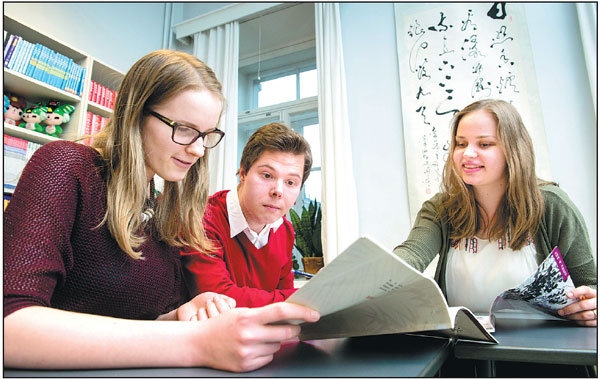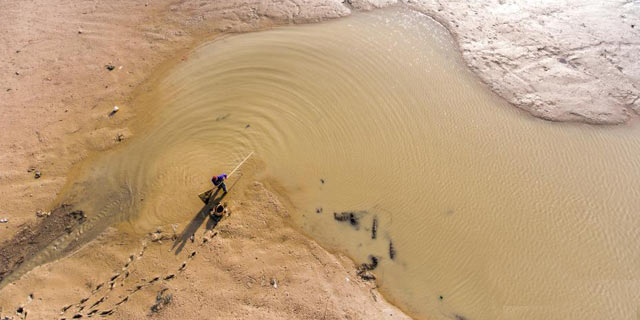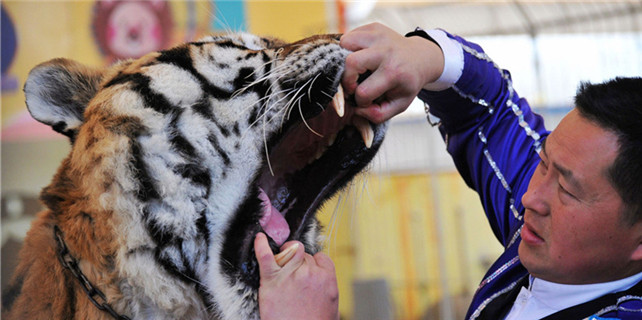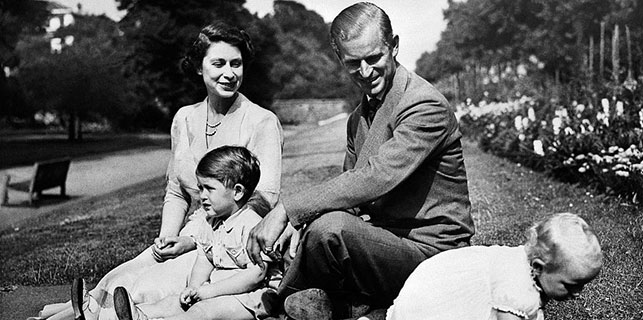Journeys of discovery
|
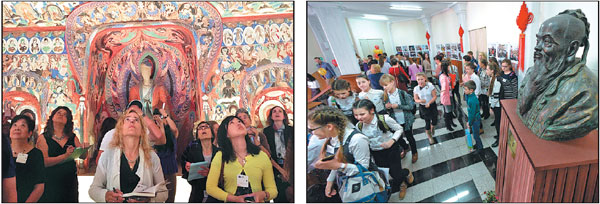 Top: College students learn Chinese at the University of Helsinki’s Confucius Institute in Denmark. Zhong Xin / For China Daily Above left: American K12 teachers visit an exhibition about Dunhuang at the Getty Center in Los Angeles, in a summer public program by UCLA Confucius Institute in 2016. Above right: Russian children attend a Chinese characters competition at a Confucius Institute in Vladivostok in February. Photos Provided to China Daily |
The UCLA Confucius Institute is spreading the spirit of the ancient Silk Road with its cultural programs and collaborations. Fang Aiqing reports.
Dunhuang, located on the edge of the Gobi Desert in Gansu province, was once a bustling oasis on the ancient Silk Road. Today it is famous for the Mogao Grottoes, one of the world's largest sites of Buddhist art.
In the eyes of Susan Pertel Jain, director of the Confucius Institute at the University of California, Los Angeles, Dunhuang was once "a cultural crossroads where people speaking different languages, holding different values and belief systems met, interacted and achieved something amazing that can still inspire us today" .
"Since the late 4th through the 14th centuries, artists from all over made artworks here," she says. "It is a place of tolerance and collaboration."
With this in mind, Jain's team has developed programs exploring different aspects of the art of the grottoes.
Last year, the Getty Center in Los Angeles held a four-month exhibition of Dunhuang art titled Cave Temples of Dunhuang: Buddhist Art on China's Silk Road. It featured models of the caves from China, along with paintings and manuscripts taken from Dunhuang in the early 20th century and held by British and French libraries and museums.
The exhibition was to celebrate the 25th year of collaboration between the J. Paul Getty Museum and Dunhuang Academy in the conservation of the cave art and preservation of the site.
Before the exhibition, the UCLA Confucius Institute was asked by the Getty Center to create public programs that would expand people's understanding of Dunhuang in collaboration with Peter Sellars, a professor at UCLA and a theater director in the United States.
Jain's team also hosted an exhibition-related concert titled East and West of Dunhuang: Music Carried on the Wind in May 2016.
Master musicians and scholar-performers of UCLA from China, India, the Middle East and Central Asia brought the ancient exchanges to life by presenting music from their own cultures.
"People may never have heard the types of music depicted in the artworks before, but the concert showed us how things happened in ancient times," Jain says.
Which in these ritual spaces, as Sellars once said, was the stimulation of all the senses.
Inspired teaching
In another program, Jain's team took history, art and sign language teachers to Dunhuang and had each of them create a lesson to bring Dunhuang into the classrooms of California's public schools.
Among them was the Mexican-American teacher, Marisela Ruiz, who taught social studies to students of the sixth grade at a school in the US where all of the students speak Spanish.
Some of their families lived in small apartments with 10 to 15 people. One of her students once told her that his bed was under the kitchen table because there was no other spare space.
Thus, on seeing Dunhuang which was abandoned for years until the beginning of the 20th century, the teacher created her lesson around the idea of "a sacred space" and what makes it special. She wanted the students to know that they could have their own special spaces despite their home situations.
Last year, she attended a six-week summer course about Dunhuang in another poor neighborhood where most students were from African and Latino communities and about one-third of the students had no parents and were in foster care.
Again, she used the idea of Dunhuang being a special place and one where people from different cultures came into contact with one another, to tell the children that it doesn't matter who they are and what kinds of life they are leading, they are still special.
The kids were taken to the Dunhuang exhibition and introduced to the dances, music and the different instruments that might have been encountered along the ancient Silk Road.
For Jain, an important goal of these public programs was to move the thinking of Dunhuang away from being simply "pretty paintings on the wall", but also a place of inspiration for global culture in the 21st century.
"If I want to get people interested in China, an artist can communicate a lot. Besides, I think artists have a way of reflecting contemporary ideas and pushing things that other people don't," Jain says.
Expanding vision
In May, the team carried out a workshop called Visioning Dunhuang. During the weeklong session, artists and experts from Russia, Ethiopia, China, Australia, the United Kingdom and the US were able to view Dunhuang art in its authentic setting and meet artists and scholars from the Dunhuang Academy.
Yulia Mylnikova, a China expert and director of the Confucius Institute at Saint Petersburg University, Russia, described it as a "creative and forward-looking initiative that brought artists and researchers with creative thinking together" .
"The approach adopted in this trip was timely and important and it has led to a number of interesting programs," Mylnikova wrote in her feedback.
According to Jain, the next workshop is planned for December. Twenty-five renowned artists such as visual artists Julie Mehretu and Anish Kapoor, jazz composer Vijay Iyer, filmmaker Lynette Wallworth and architect Greg Lynn will be participating.
For Jain, what began as a short-term collaboration with the Getty Center around the Dunhuang exhibition has become a major international arts initiative for UCLA that will connect to major cultural and educational partners around the world over the next 10 years.
"The project will tap the network of educational partners created through the Confucius Institute initiative," says Jain, who was speaking in Beijing in September during a visit to attend the 2017 Confucius Institute Open Day. The theme of this year's conference was "My story with Confucius Institute" .
Directors, Chinese language teachers, volunteers and students of the Confucius Institute branches, as well as writers, scholars, filmmakers and entrepreneurs were invited to share their stories and connotations of bridging the exchanges between Chinese and foreign cultures in terms of language education, art, music, literature, films and technology.
More than 360 Confucius Institute branches in more than 100 countries were celebrating the Confucius Institute Open Day at the same time.
Contact the writer at fangaiqing@chinadaily.com.cn







